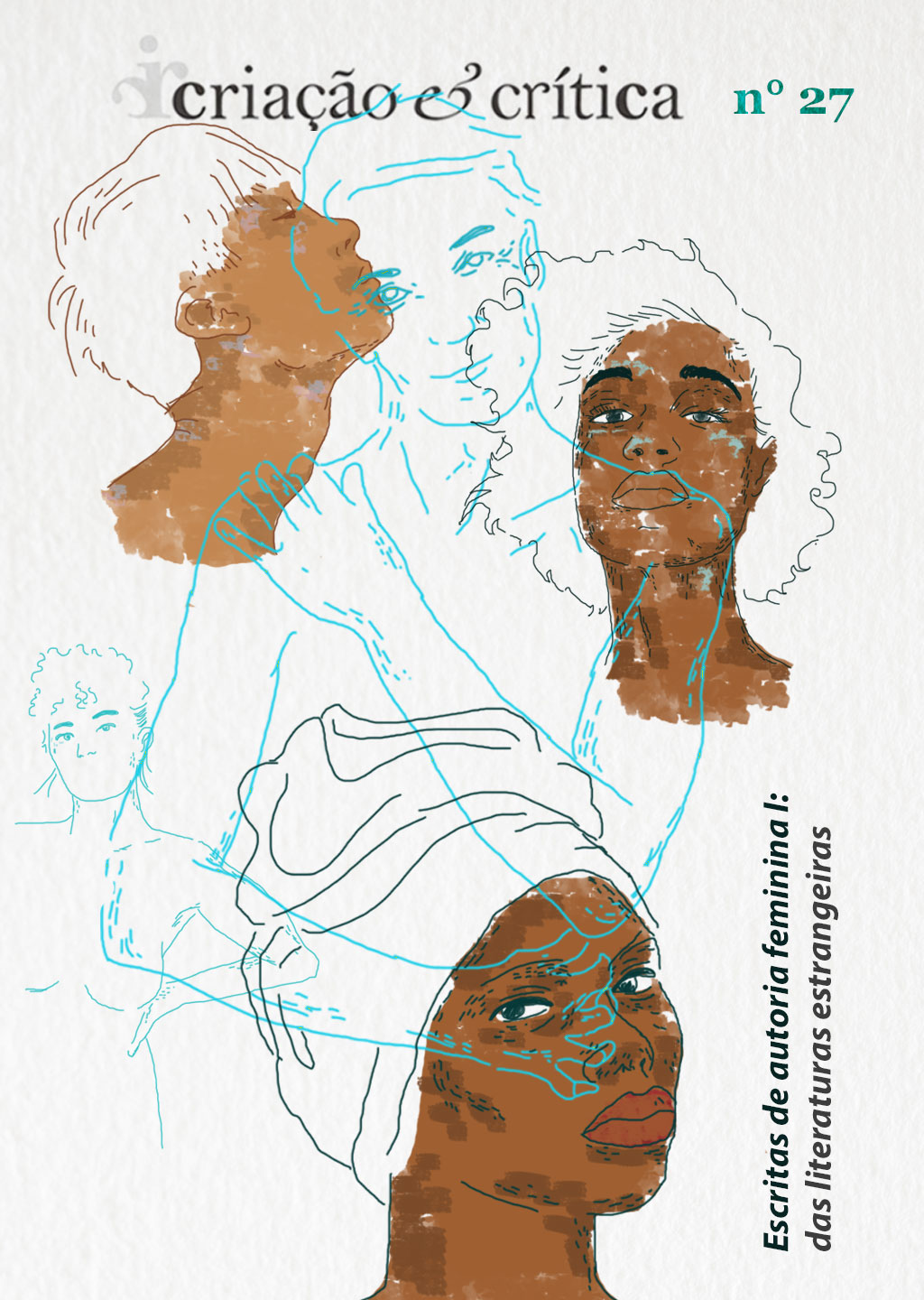Trauma e possíveis caminhos para a cura em O olho mais azul: a história de Pecola e a narração de Cláudia
DOI:
https://doi.org/10.11606/issn.1984-1124.i27p139-162Palavras-chave:
Literatura Norte-americana, Literatura Afro-americana, Trauma, Toni Morrison, O Olho Mais AzulResumo
O Olho Mais Azul traz a história de Pecola, uma menina negra que sofre diferentes formas de discriminação e abuso devido àcor de sua pele. Como resultado de toda a dor e sofrimento (incluindo um estupro incestuoso) a que a garota é subjugada, elaacaba por perder sua sanidade. Portanto, um dos objetivos deste artigo é o de analisar como o trauma é representado no livro, considerando as muitas microagressões às quais Pecola é exposta e que resultam em traumatização insidiosa. Considerando que a história da jovem é revisitada anos depois por Cláudia, sua amiga de infância, este trabalho também busca examinar alguns caminhos para a cura que a narradora parece sugerir. A fim de cumprir esses objetivos,alguns conceitos relacionados atrauma são apresentados e analisados em relação à sua representação no livro. Além disso, o papel crucial do conhecimento e cultura afroamericanas para a sobrevivência de Cláudia também é discutido. O resultado desta análise mostra que a narrativização é apresentada como possível cura para a traumatização de uma comunidade e que a conexão com valores afro-americanos pode auxiliar ainda mais nesse processo.
Downloads
Referências
BRISON, S. “Trauma Narratives and the Remaking of the Self.” In: BAL, M.; CREWE, J.; SPITZER, L. Acts of Memory: Cultural Recall in the Present. Lebanon: University Press of New England, 1999, p. 39-54.
BROWN, L. “Not Outside the Range: One Feminist Perspective on Psychic Trauma”. In: CARUTH, C. Trauma: Explorations in Memory. Baltimore: The Johns Hopkins University Press, 1995, p. 100-112.
CARUTH, C. Trauma: Explorations in Memory. Baltimore: The Johns Hopkins University Press, 1995.
CARUTH, C. Unclaimed Experience: Trauma, Narrative, and History. Baltimore: The Johns Hopkins University Press, 1996.
CRAPS, S. Postcolonial Witnessing: Trauma Out of Bounds. London: Palgrave Macmillan, 2013.
DEGRUY, J. Post Traumatic Slave Syndrome: America’s Legacy of Enduring Injury and Healing. Milwaukie: Uptone Press, 2005.
FREUD, S. The Complete Writings (Arthur Wallens Classics). A.W. Books, 2006, Kindle Edition.
HOOKS, b. Ain’t I a Woman: Black Women and Feminism. Abingdon: Routledge, 2015.
Imitation of Life. Dir. John M. Stahl. Screenplay by William Hurlbut. Universal Studios, 1934. Film.
MALMGREN, C. “Texts, Primers, and Voices in Toni Morrison’s The Bluest Eye”. In: BLOOM, H. Bloom’s Modern Critical Interpretations – Toni Morrison’s The Bluest Eye – Updated Edition. New York: Infobase Publishing, 2007, p. 145-158.
MORRISON, T. The Bluest Eye. New York: Vintage Books, 1999.
MORRISON, T. Playing in the Dark. New York: Vintage Books, 1993.
MORRISON, T. “Toni Morrison Talks About Her Motivation For Writing”. Online video clip. Youtube. Youtube, 2008. Available at <https://www.youtube.com/watch?v=_8Zgu2hrs2k>. Accessed on June 24th, 2020.
MOSES, C. “The Blues Aesthetic in Toni Morrison’s The Bluest Eye”. In: BLOOM, H. Bloom’s Modern Critical Interpretations – Toni Morrison’s The Bluest Eye – Updated Edition. New York: Infobase Publishing, 2007, p. 125-144.
NEAL, L. “The Black Arts Movement”. The Drama Review: TDR, Cambridge, Vol. 12, No. 4, p. 28-39, 1968.
PALMER, C. “Civil Rights Movement, U.S.”. In: PALMER, C. Encyclopedia of African-American Culture and History. Farmington Hills: Thomson Gale, 2006, p. 417-478.
RAMBSY II, H.; SMETHURST, J. “Reform and Revolution, 1965-1976: the Black Aesthetic at Work”. In: GRAHAM, M.; WARD, J. The Cambridge History of African American Literature. Cambridge: Cambridge University Press, 2011, p. 268-287.
RUCKER, W. “Black Power”. In: ALEXANDER, L.; RUCKER, W. Encyclopedia of African American History. Santa Barbara: ABC-CLIO, 2010, p. 662-664.
TASSO, T. Gerusalemme Liberata. Scotts Valey: CreateSpace, 2015.
VISSER, I. “Decolonizing Trauma Theory: Retrospect and Prospects”. In: ANDERMAHR, S. Decolonizing Trauma Studies: Trauma and Postcolonialism. Basel: MDPI, 2016, p. 7-23.
VISSER, I. “Trauma theory and postcolonial literary studies”. Journal of Postcolonial Writing, Abingdon, v. 47, n. 3, p. 270-282, 2011.
WERRLEIN, D. “Not so Fast, Dick and Jane: Reimagining Childhood and Nation in The Bluest Eye”. In: BLOOM, H. Bloom’s Modern Critical Interpretations – Toni Morrison’s The Bluest Eye – Updated Edition. New York: Infobase Publishing, 2007, p. 193-208.
WHITEHEAD, A. Trauma Fiction. Edinburgh: Edinburgh University Press, 2004.
Downloads
Publicado
Edição
Seção
Licença
Copyright (c) 2020 Rosana Ruas Machado Gomes

Este trabalho está licenciado sob uma licença Creative Commons Attribution-NonCommercial-ShareAlike 4.0 International License.
Autores que publicam nesta revista concordam com os seguintes termos:
a. Autores mantém os direitos autorais e concedem à revista o direito de primeira publicação, com o trabalho simultaneamente licenciado sob a Licença Creative Commons Attribution que permite o compartilhamento do trabalho com reconhecimento da autoria e publicação inicial nesta revista.
b. Autores têm autorização para assumir contratos adicionais separadamente, para distribuição não-exclusiva da versão do trabalho publicada nesta revista (ex.: publicar em repositório institucional ou como capítulo de livro), com reconhecimento de autoria e publicação inicial nesta revista.
c. Autores têm permissão e são estimulados a publicar e distribuir seu trabalho online (ex.: em repositórios institucionais ou na sua página pessoal) a qualquer ponto antes ou durante o processo editorial, já que isso pode gerar alterações produtivas, bem como aumentar o impacto e a citação do trabalho publicado (Veja O Efeito do Acesso Livre).



